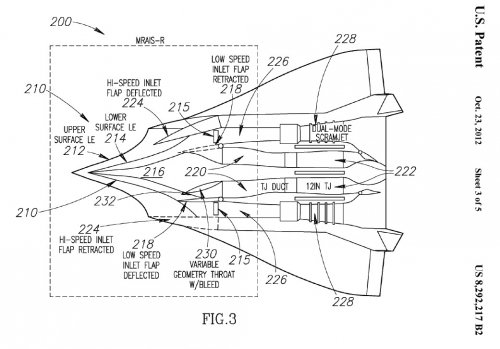http://www.freepatentsonline.com/8292217.html
Hypersonic inlet systems and methods Document Type and Number: United States Patent 8292217
Abstract: Hypersonic inlet systems and methods are disclosed. In one embodiment, an inlet for an airbreathing propulsion system includes an inboard surface at least partially shaped to conform to a plurality of streamline-traces of a design flowfield approaching an aperture, an outboard surface spaced apart from the inboard surface, an upper surface extending between the inboard and outboard surfaces, and a lower surface extending between the inboard and outboard surfaces, wherein leading edges of the inboard, outboard, upper, and lower surfaces cooperatively define the aperture.
Inventors: Smith, Thomas R. (Westminster, CA, US)
Espinosa, Angel M. (St. Charles, MO, US)
Farrell, Daniel J. (St. Louis, MO, US)
Robertson, Andrew (West Sayville, NY, US)
Leylegian, John C. (White Plains, NY, US)
Tyll, Jason S. (Blue Point, NY, US)
Girlea, Florin (Flushing, NY, US)
Alifano, Joseph A. (Ronkonkoma, NY, US)
Chue, Randy S. M. (Bohemia, NY, US)
Application Number: 12/133289 Publication Date: 10/23/2012 Filing Date: 06/04/2008 View Patent Images:
Download PDF 8292217 PDF help Export Citation: Click for automatic bibliography generation Assignee: The Boeing Company (Chicago, IL, US)

